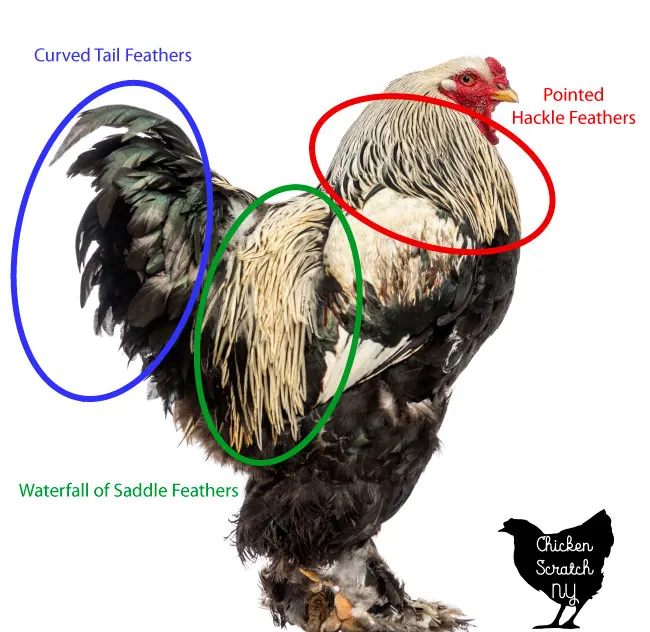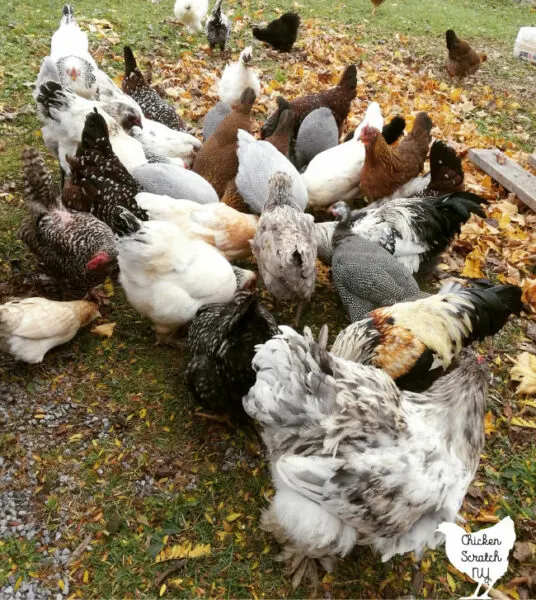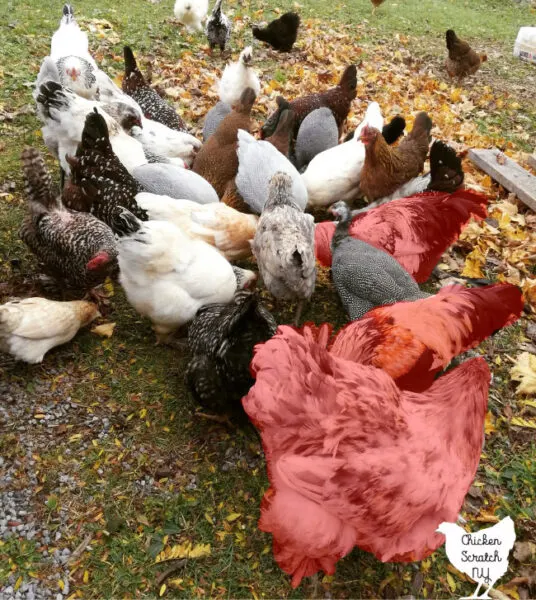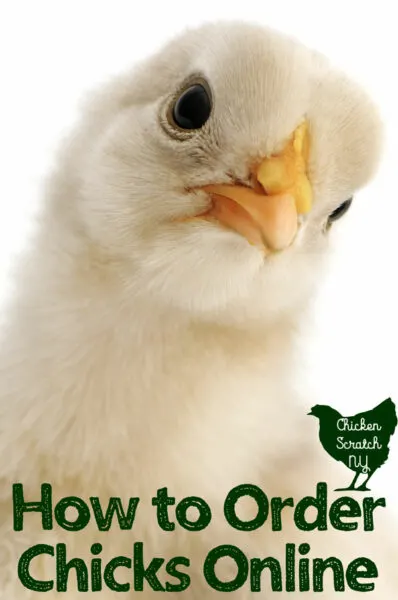Chicken sexing at a young age is a bit of an art. Even with years of experience I find myself staring down the growing babies looking for signs that they’ll be egg-laying hens or yet another rooster.

I wanted to share what I look for when my chicks are growing up. They should help you out if you’re wondering if you should be prepping the soup pot or the nest boxes.
There are several ways to tell roosters from hens, some are pretty obvious and some not so much. A few methods can even be misleading.
Eggs

If it lays an egg it’s a hen! It doesn’t matter how large and red the comb is, how big it’s spurs are or how loudly it crows. If there is an egg it is a hen.
However, that’s going to take 18-20+ weeks to happen so we’ll go over some more helpful ways to tell hens from roosters.
I’m adding this for some comic relief but at the same time you’d be surprised how often I see Facebook posts asking why they have one rooster and one hen but they get two eggs a day.
I’ve seen hens with spurs, hens that crow and even hens that mount other hens. It doesn’t matter how rooster-y they act, if they lay eggs you can be certain you have a hen.
Saddle and Hackle Feathers

This is my main method of telling hens from roosters. The object here is to identify the boys. If there aren’t any saddle feathers you can be pretty certain you’ve got a lady.
There are a few exceptions to this rule. Silkie, Sebright, and some Golden Campine roosters are called ‘hen feathered’ because they lack the district saddle and hackle feathers.
Roosters have elongated, narrow and pointy saddle feathers on their sides right in front of the tail. They spill over the sides like a waterfall.
These feathers start showing up around 8-10 weeks. Usually by 12 weeks they’ll be impossible to miss. Depending on the breed they may be colored differently than the other feathers.
Hackle feathers are found on the neck, in roosters they are also elongated and pointy. Hens also have hackle feathers but they will be more rounded at the ends. I pretty much ignore the necks and trust the saddle feathers to tell me what I need to know.
If you’ve ever seen two roosters fighting and it looks like they swallowed an umbrella, that’s the hackle feathers in action.
Rooster Tail Shape
The most obvious tail clue is the presence of sickle feathers. Sickle feathers are the long, beautiful arched tail feathers that roosters have.
Unfortunately, they seem to take the brunt of rooster-on-rooster aggression and they don’t always stay stunning. I’ve also noticed a 50/50 shot on my Cochin roosters having long tail feathers.
Cochins are a very fluffy, soft-feathered breed and these features can be a little harder to see from far away or if you aren’t sure what you’re looking for.
The tails can also give you a few clues before those pretty sickles feathers grow in. When the tail feathers grow in you’ll notice that hens tails end bluntly. The feathers themselves will have rounded ends.
Rooster tails will start to arc at the end and the feathers will be pointier. In general, roosters seem to be pointier, both in appearance and personality.
Breed Specific Sex Characteristics:
Red on the wings is a sign that an Easter Egger chick is a rooster. All my EE roos have been evil but they are so beautiful!

That guy above was a jerk, you can see the red coloring on his wing. If you look closely you can also see the pointed hackles and the arching tail.
Male Welsummer chicks have a black chest that shows up when they lose the down and start going in regular feathers. The chest on pullets (females) will be red.
Barred chicks will show a difference as day-old chicks, males will have a large light-colored spot on the head and on females it will be smaller. I’ve never tried it but it’s supposed to be 80% correct.
A few not-so-helpful methods
Now that we’ve covered all the things I do look for, I want to tell you some of the less helpful advice on chicken sexing I’ve seen thrown around.
Comb Size
Comb size is hands down the most misleading characteristic used to sex chickens in a mixed flock.
If you’ve only got one kind of chickens you’re probably safe to compare and guess.
There are a few generalities that have some truth behind them, the only useful one is rooster combs turn red sooner than hens. This is something I look for but I’m not about to bet money on it.
Going back to those Facebook groups, I was once in a chicken group conversation with someone insisting that his hen was laying 3 eggs a day because the rest were roosters. The rest were not roosters, they were leghorns with giant floppy combs typical for the breed.
Not all roosters will get a giant comb like that pretty boy on the Kellogg box, comb shape and size is determined by genetics. I live in a cold climate with awful winters and I personally favor chickens with small combs for their cold hardiness.
Check out my post on heritage breed chickens built for cold weather to find out more about that.
My Cackle Hatchery surprise box did provide me a with a few large comb breeds. The largest combs on my farm belong to my two brown leghorn hens.
Spurs
Spurs are most likely to show up on roosters but hens can have them. And all chicks will have a little bump where the spur might grow. Right now I have a Cuckoo Maran with big old spurs, unrelated but shes a great mom.
They don’t grow in until around 3-8 months so I don’t put a lot of importance on them at all. By the way, this is Bruce, he was my favorite rooster ever.
He had giant spurs and overall bad feet but he was a sweetheart and a big reason why Brahmas are my favorite chickens.
Crowing
Hens can crow. Did you know that?
Crowing is much more common in roosters but those egg-laying ladies can do it too. It’s most likely to happen in a flock without a rooster.
I hope you have found these chicken sexing methods helpful. Figuring out what type of chick you have and if it’s a boy or girl are the trickiest part of having a mixed flock.
Both those things are easier when you only have one type to compare. I love having a mix of egg colors and personalities in my backyard flocks so I’ll keep it complicated as long as I have chickens.

Speaking of a mixed flock, how many roosters do you see in this picture? I’ll put the answer at the bottom.
Don’t forget to PIN this to your Chicken board, check out my Chicken Page for more information or start here:
There are THREE roosters in that shot, from front to back: a giant grey Cochin, an EE and a silver laced Cochin.






Kim
Wednesday 22nd of May 2024
Ty still confused lol thing I have a roo when all wer to be hens
Alecia
Saturday 25th of May 2024
Unfortunately sexing chicks isn't an exact science. It's a numbers game and if you get enough chicks eventually they'll mess up
Linda
Saturday 4th of November 2023
In your count the roosters pic, near front just behind the foremost gray and white bird, there's a multicolored one ( black tail. Tan.& Rust colored feathers) What breed is this. Recently given one just like it, but breed unknown.
Alecia
Tuesday 7th of November 2023
He was an Easter Egger mix that was born here, he could be anything lol
Sam
Tuesday 24th of October 2023
This helped a lot! But do you know hiw to tell when they are babies?
Alecia
Wednesday 25th of October 2023
Unless you have a sexlink breed where they are different colors the only way to tell as chicks is by vent sexing. It's not 100% accurate and you can hurt them so I don't even try
Rene Rogers
Friday 6th of October 2023
Thanks for the laughs!😆😆😆 I love reading about chickens and am astounded at what some people say or think. This is a great post with great information.
Rena
Monday 18th of September 2023
New to chicken raising and have a dozen chickens, mixed breeds. I have one hen that definitely let's the others know she is boss. My Wynadottes are beautiful, but are a more aggressive breed thus far. They are around 14 weeks old and should be getting ready to start laying. What should I put in their coop for a comfortable nesting box padding, or is anything even necessary?